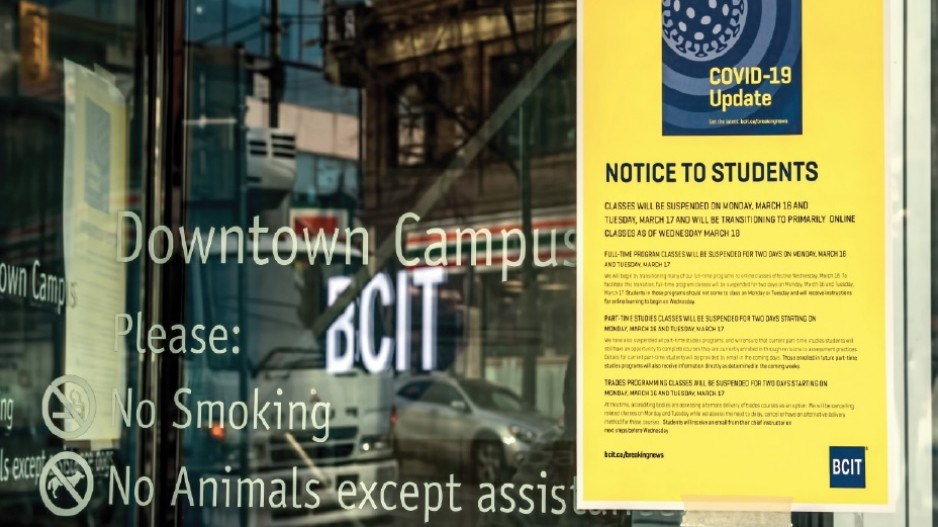Although B.C. schools have limited statistics available, the international education sector could suffer long-term, if not irreversible, damage from the COVID-19 pandemic.
That’s because even if the ongoing entry ban for foreign nationals into Canada is lifted, it will take years for international students, many of whom apply to study in Canada for lifestyle as much as educational benefits, to feel comfortable with the level of global mobility that helped drive the sector prior to the outbreak.
Business in Vancouver contacted six post-secondary institutions – the University of British Columbia (UBC), Simon Fraser University (SFU), Kwantlen Polytechnic University (KPU), Capilano University, the British Columbia Institute of Technology (BCIT) and Trinity Western University – about international student enrolment numbers this year and projections for the upcoming school year. Only UBC, SFU and KPU responded to the request, with KPU showing 5,024 international students for the 2018-19 school year (2019-20 final numbers are not available until August).
UBC declined to issue enrolment counts and projections of COVID-19’s impact next year, noting in its statement that “the situation is evolving so it is difficult at this time to estimate how enrolment at UBC will be impacted.”
But the university said that application volume is comparable to last year’s, although UBC’s March 15 international application deadline means that most students would have submitted their packages prior to the outbreak-induced lockdown that began in mid-March.
SFU was the most thorough with its figures. It charted a steady increase of international undergraduate students from 2010 (3,578) to 2019 (5,325).
Decreases last year in the number of students from China compared with 2018 (from 2,729 to 2,645) were offset by gains in markets like India (377 to 467), Vietnam (208 to 258) and Bangladesh (63 to 92). SFU confirmed that fall 2020 international student enrolments are on par with 2019, but cautioned that it is too early to predict the final numbers. (SFU’s international application deadline is March 31).
But sector insiders say schools should expect a big drop in international enrolment in the fall, if only because the Canadian entry ban for foreign citizens may still be active by September. Such a ban would prevent any students from outside Canada to enter the country and attend classes.
According to federal statistics, international students contributed an estimated $21.6 billion to Canada’s GDP, supporting close to 170,000 jobs through education and other knock-on sectors such as housing, retail and services. The sector was viewed as a key economic driver for Canada and B.C. as Ottawa in 2019 allocated $147.9 million over five years to expand the industry.
Even if the travel ban is lifted by September, it wouldn’t come close to solving all the challenges the industry now faces.
“The travel ban is the worst-case scenario, but even assuming things go back to normal eventually, things won’t be back to normal by this fall,” said Hugh Stephens, principal of consultant group Trans-Pacific Connections and an associate faculty member at Royal Roads University’s MBA program. “First of all, I think a lot of students will say to themselves to just wait a year. There will be a chilling effect on applications for the year.”
Stephens added that international education is built around the in-person experience of going abroad to study, to interact with different cultures and to experience an adventure.
B.C. schools’ efforts to recruit international students beyond the school year that starts this fall will be even more challenging because of the uncertainty about international mobility in a post-COVID world.
The departure of international students isn’t as big a concern for UBC history professor Henry Yu, who is also principal at the school’s St. John’s College, which has an international focus. Yu said that since the lockdown began in mid-March, only about 10% of his students have decided to return to their home countries (or, in some cases, went home for spring break and were unable to return to Canada due to the border entry ban), while most have decided to stay put.
“We have a community that has tried as hard as possible to maintain a sense of community,” Yu said. “Is there some other better place to be? Some people rather go through this with family, but for many others, this is the best place in the world to weather this crisis. Vancouver’s better off than Quebec and Ontario, and the sense that this is a great place to be hasn’t changed.”
However, Yu was more pessimistic about enrolment trends for international students in the fall.
“My assumption as a historian is that I would find it very, very unlikely that we are back to normal in September, we meaning the world. If you are going to reopen a campus like this in September, you are bringing people from 150 countries, mixing them with another 40,000 people coming in and out of campus everyday. If you are a virus, there’s no better place to spread. So even if the outbreak is calm around the world by that point, it’s still a terrible idea…. So if you open up a campus in September, one of the conditions should be a guarantee that not a single person coming in is a carrier; and that’s a lot of people in a lot of places you have to track.”
Yu added that, even when global mobility returns in some form, it won’t look like what it did prior to COVID-19. What form will the industry look like post-pandemic? No one knows for sure, he said.•




